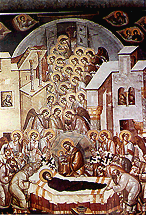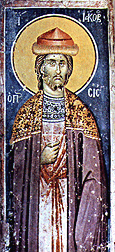 |
|
 |
Ohrid - St Kliment
 he church of St Kliment in he church of St Kliment in
 Ohrid,
founded in 1294/5 by the Byzantine official and son-in-law of the Emperor
Andronikos II Palaiologos, Progonos Sgouros, was originally dedicated
to the Virgin Peribleptos. The frescoes are the work of two painters from
Thessalonike, the Eutychios and Michael Astrapas, whose signatures and
monograms may be seen at various points of the painting: on the blade
of St Mercurius' sword, for example, is inscribed "cheir Michael tou Astrapa"
(by the hand of Michael Astrapas), while the names of both artists are
inscribed on the bands decorating the mantle of two other military saints.
These two eminent painters from Thessalonike, who were later engaged to
adorn a series of churches founded by the
kralj Milutin, such as St
Niketas at Cucer (before 1316) and St George at Staro Nagoricino (1317),
established a school of painting in Serbia. The iconographic programme
of the church of St Kliment does not present any particularities. Ohrid,
founded in 1294/5 by the Byzantine official and son-in-law of the Emperor
Andronikos II Palaiologos, Progonos Sgouros, was originally dedicated
to the Virgin Peribleptos. The frescoes are the work of two painters from
Thessalonike, the Eutychios and Michael Astrapas, whose signatures and
monograms may be seen at various points of the painting: on the blade
of St Mercurius' sword, for example, is inscribed "cheir Michael tou Astrapa"
(by the hand of Michael Astrapas), while the names of both artists are
inscribed on the bands decorating the mantle of two other military saints.
These two eminent painters from Thessalonike, who were later engaged to
adorn a series of churches founded by the
kralj Milutin, such as St
Niketas at Cucer (before 1316) and St George at Staro Nagoricino (1317),
established a school of painting in Serbia. The iconographic programme
of the church of St Kliment does not present any particularities.
 Its upper part is decorated with Christological scenes in continuous zones
that are characterised by the drama and intensity of the narrative. In
the next, narrower zone, is represented an extensive
Mariological cycle , once
again in a continuous narration. The large space devoted to the life of
the Virgin is due to the fact that the church was initially dedicated
to her. Stylistically, the representations in St Kliment are characterised
by heavy, massive figures with expressive faces, and by the angular, cubistic
rendering of the drapery. The attitudes and movements are intense and
dramatic. The wall paintings are generally distinguished by an exaggeration
in the use of expressive means and in the rendering of volume. They thus
constitute the culminating point of the so-called volume style that begins
to emerge in art in the middle of the century, and is characterised by
the special emphasis given to the three-dimensional rendering of the figures
and the garments.
Its upper part is decorated with Christological scenes in continuous zones
that are characterised by the drama and intensity of the narrative. In
the next, narrower zone, is represented an extensive
Mariological cycle , once
again in a continuous narration. The large space devoted to the life of
the Virgin is due to the fact that the church was initially dedicated
to her. Stylistically, the representations in St Kliment are characterised
by heavy, massive figures with expressive faces, and by the angular, cubistic
rendering of the drapery. The attitudes and movements are intense and
dramatic. The wall paintings are generally distinguished by an exaggeration
in the use of expressive means and in the rendering of volume. They thus
constitute the culminating point of the so-called volume style that begins
to emerge in art in the middle of the century, and is characterised by
the special emphasis given to the three-dimensional rendering of the figures
and the garments.
The monument belongs to the architectural type of the
cross-in-square church.
It presents such similarity, both in design and in the exterior masonry,
to the so-called Kokkine Ekklesia ("red church") in Bulgareli
of Epiros so the scholars suggest that these two monuments were built
by the same building workshop.
|